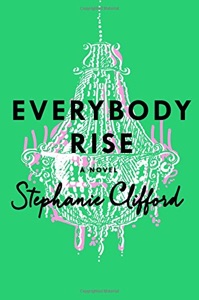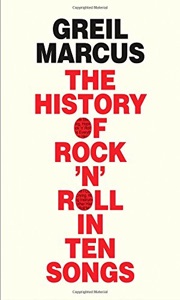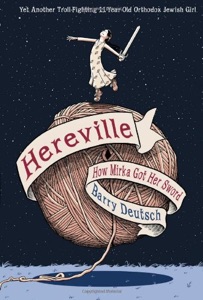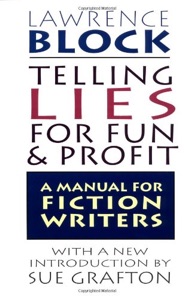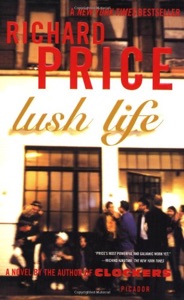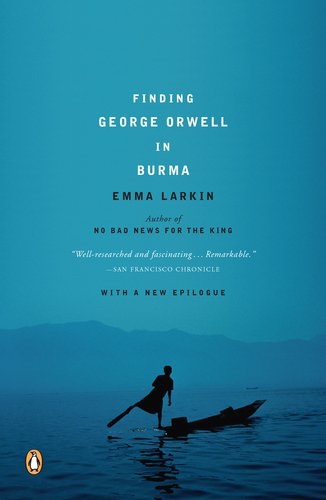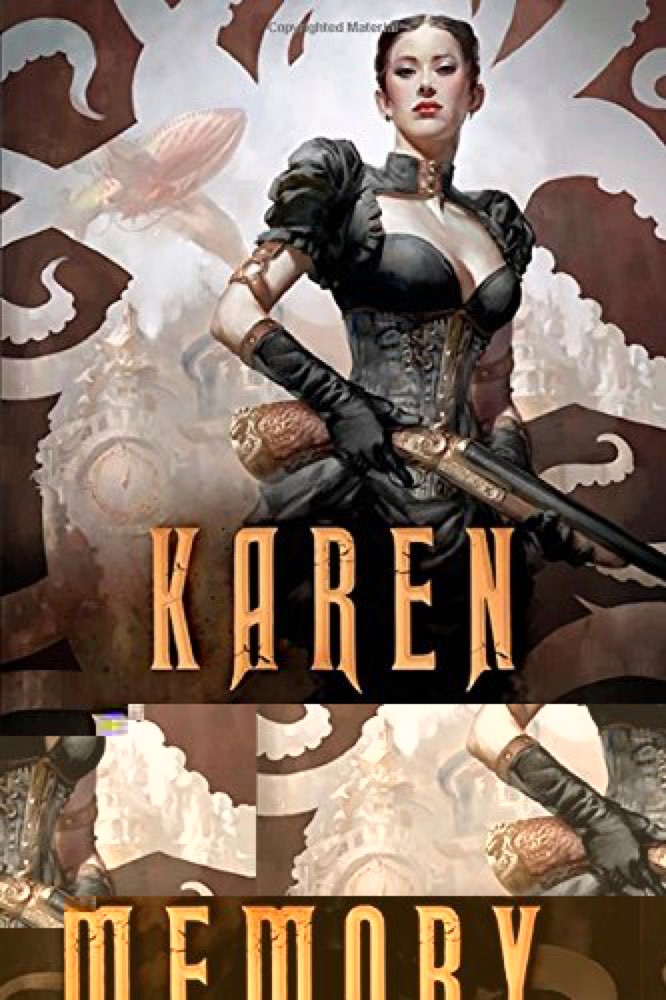Nice 10-minute YouTube video on social graphs, with some decent not-too-handwavy graph theory. Via David Kolb.
The discussion of hypertext fiction in the past decade has often been dominated by the question of immersion. If the reader is asked to make choices or to follow links, doesn’t that distract them from the perfluent dream, from getting lost in the book?
Michael Dirda’s essay on reading “After The Golden Age” is a useful reminder here that grownups don’t read the way kids read. In those long mythic afternoons of your Golden Age, sure, maybe you did read Sherlock Holmes and Tolkien, thinking of nothing more than whether Sherlock would solve the puzzle or whether Frodo could ever evade the armies of Mordor.
You could do that because you didn’t know anything and you didn’t know better. You paid no attention to craft: books happen, like dinner, they’re not something you make, they’re something you expect and, if they don’t appear when needed, something you ask for. You didn’t argue with the author, either, because you were a kid and kids don’t argue with grownups (except their parents of course). You didn’t stop to compare Sherlock to Poirot or Spade or Wimsey or Longmire because you were a kid and you hadn’t yet met the others.
Sure, you can recapture some of that sense of immersion with the right book at the right moment. You can get something like it for a while in film and theater, and perhaps in some computer games. Wine is the thing that makes us happy for no reason: there’s a reason why sex and drugs and rock ’n’ roll go together. Still, you can’t really go home again, and you only imagine that you want to.
Every year, we have a few conferences that concern literary hypertext, electronic literature, hypertext narrative, or what you will.
At conferences like these, one finds two kinds of papers. We have papers intended to be presented, justifying the author’s travel costs, tenure, and grants, and we occasionally have papers intended to be read, papers that call attention to work the author admires or detests, papers that try to move current practice or change current taste.
I’m not talking only about papers intended for a broad audience. The second type of paper might be written, for example, for a very small audience of technological experts. But these papers are meant to be read, and perhaps discussed and argued about; the other sort are meant to be admired.
My desk is now awash in monographs and papers: Mason’s “On Games and Links,” the new(ish) Janet Murray monograph that nobody (literally) mentioned to me, Harmut Koenitz’s collection on Interactive Digital Literature. What have I have missed? And where are the arguments over it?
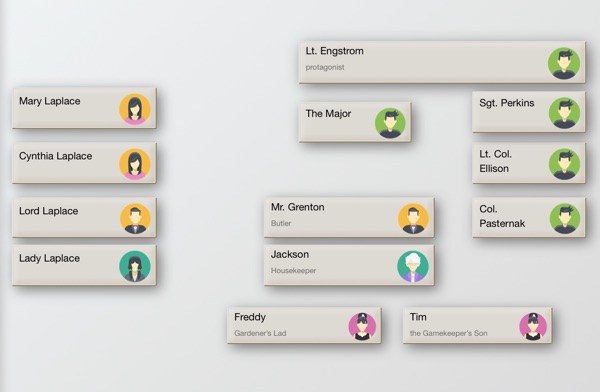
Here’s a shot from the a corner of one of my Storyspace 3 experiments. It’s a conventional map view, but in one part of the map I’m keeping track of a bunch of characters. (The experiment involves a party at a country house. It’s a quick study, so I’ve got a bunch of names to remember.)
One distinctive feature of Storyspace has always been its dynamic links – specifically its guard fields, which effectively turn links on and off as the reader moves through the work. Guard fields are indispensable for large hypertexts; you can manage, some of the time, with visited link colors, but guard fields are far more expressive. The classic Storyspace syntax for guard fields was somewhat limited and a bit tricky; Storyspace 3 will make this better.
Another key feature of Storyspace is the notion of the default link. Most of the time, if you don’t know which link you want to follow, you can just press “return” and let the author choose the link for you. This was controversial in the early days, back when “free and knowing navigation” was widely regarded as the touchstone of hypertext. Now we understand that, much of the time, we don’t know what we want or how to find it: that’s why we’re reading. Even when you’re reading against the grain, the presence of default links is transformative. Again, Storyspace 3 continues to support default links in the conventional way, and also will introduce a new sculptural hypertext facility that makes it easy to provide interesting default links.
Today, I’m working on a short robotic hypertext, an interactive-fiction flavored confection intended to demonstrate some of Storyspace 3’s facilities, new and old, for manipulating story (what happens) rather than plot (how it’s told).
This is not really the sort of thing I especially like, and so it’s not congenial work and its hard to bring much conviction to the task. Throughout this project to sketch “Getting Started With Hypertext Narrative,” I’ve been convinced that it’s all crap. Or worse.
This, I realize, is garden variety Writers Block, and here of the mildest form because despite this exceptionally fierce outbreak of the malady I’m still managing 3 or 4 thousand words a day in the course of finding bugs and inventing new facilities.
by Stephanie Clifford
It’s all right.
It’s OK.
You’re gonna work for us one day. – prep school cheer
Gotta give Stephanie Clifford credit for wicked invention (or, perhaps, close observation?)
by Greil Marcus
Stylish, well-written, and engaging, this modest book explores ten songs that shaped or reshaped Rock – often through reinterpretation over many years. One chapter, for example, looks at the saccharine “To Know Him Is To Love Him”, recorded in 1958 by The Teddy Bears and written by their tenor, a very young Phil Spector. The song was completely transformed in 2006 by Amy Winehouse. (Another version.)
When Amy Winehouse sang it in 2006, her music curled around Spector’s, his curled around her, until she found her way back to the beginning of his career, and redeemed it. Whether he has every heard what she did with his music, or whether she ever heard what he thought of what she did, are unanswered questions. He isn’t talking; she can’t.
The much-disputed Hugo travesty comes to a head this weekend, and we’ll find out how (and whether) the prestigious science fiction award can be taken back from the misogynistic Gamergate-inspired crew that used a block-voting loophole to seize the nomination process.
Meanwhile, the Romance Writers of America nominated Kate Breslin’s For Such A Time in two categories – Best First Book and Best Inspirational Romance. The book’s romance connects a young, blonde, Jewish woman in Dachau with Aric, an SS officer and extermination camp commandant. In the end, the Nazi helps save some Jews, the Jew converts to Christianity, and everything’s cool, right?
Unsurprisingly, the nomination has been controversial. (More in The Guardian and The Forward)
"No one considered that the female character’s life at the hands of the male character’s might make it impossible for her to consent. No one considered that this might not be romance but rape. No one considered that after thousands of years of forced conversions, Jewish people might find a novel romanticizing conversion to be problematic. –
I’m working on a big Storyspace project, one that involves revisiting past broils and former controversies. One is Janet Murray’s assertion that digital media are inherently inclined to be encyclopedic. I think that this seems to self-evident that it has seldom been questioned, but it the encyclopedic impulse inherent in the digital, or merely inherent in text?
In any case, very little has been written about the craft of this encyclopedic impulse, about mastering it in the service of the story. Murray’s own view
When the encyclopedic affordance is appropriately exploited, large information resources are semantically segmented at multiple levels of granularity, sorted, classified, and labeled with controlled vocabularies. When informational spaces or virtual worlds are well organized with clear boundaries, consistent navigation, and encyclopedic details that reward exploration they create the experience of immersion.
is a list of Information Architectural virtues, but these virtues are very much at odds with the impulse. The impulse, if it exists, calls for grand vista of vast information spaces, complex and subtle, in which we can lose ourselves; clear boundaries and consistent navigation are something else entirely. We’re arguing that nature in all its wild exuberance and its terrible sublimity is the true subject of art, and so we should all go into the back yard and do some gardening.
The Yiddish bubbe meisse means a silly story or wishful fantasy. Most people think “bubbe” here is the word from “grandmother” but it’s not: it’s Sir Bevis from the Arthurian cycle, showing up in the shtetl where you wouldn’t really expect him. Go figure.
Anyway: how do we master the encyclopedic impulse without being sucked into the endless task of creating an infinite world in infinite detail?
The most straightforward approach to blending narrative and annotation is the Parsifal story, that memory of ritual initiation in which the hero sees a succession of wonders – often frightening, always incomprehensible – which he comes eventually to understand and, in understanding, comes into adulthood. This is the story of going walkabout, of Lyra’s harrowing of Hell, of The Magic Flute, of True Grit and of The Road To Oxiana.
The Parsifal Story integrates the encyclopedic impulse with narrative by entwining them twice. First, our natural expectation calls for a journey followed by exposition of the marvel we will witness. Afterward, we will journey again, and again we expect a new wonder. Exposition of the marvel we have worked to see is not here an interruption in the story, but becomes a goal of the story, part of what we and the hero are seeking. Moreover, because we understand that the end requires understanding, not simply witnessing, these marvels, the hero’s struggle to decipher and interpret itself becomes a narrative.
The very convenience of this narrative device is its chief drawback: readers who recognize Parsifal perceive the puppet master behind the characters and naturally resent the master’s manipulations. Why should we sit through this long stream of phony perils and mumbo jumbo? If you’ve got knowledge to impart, why not get on with it? The Yiddish term for a silly story, one only a child would sit still for, is bubbemeise from Sir Bevis, another Parsifal story.
One way to justify Parsifal is to disable the hero, to so limit their agency that they can do little more than witness and interpret. In True Grit, Mattie Ross is a child and a woman in a man’s world. In Pry, the electronic novella by Danny Cannizzaro and Samantha Gorman, the hero is paralyzed: all he can do is witness and remember. In Tinker Tailor Soldier Spy, George Smiley is old, retired, cast out, a former spy called in to clean up a small mess.
Finally, when considering the Parsifal structure in hypertext, keep in mind that Parsifal often requires progressive revelation. The psychological impact of the mystery, for example, depends not on our assembling clues and performing deduction, but rather on the hero’s ultimately-successful effort to repair (at least partially) a breach in the world’s proper order. The clues might come in any sequence but the clues don’t matter: what matters is the progressive impact of growing knowledge (both of the rupture and its cure) on the hero. That progress is linear.
From the new Storyspace project. Comments, corrections, suggestions, and cries of pain and outrage all embraced: Email me.
by Barry Deutsch
The cover explains that this graphic novel concerns “yet another troll-fighting 11-year-old orthodox Jewish girl,” and it is not wrong. Hayao Miyazaki meets small-town upstate New York, where Mirka deals with the great decisions of school life (one open button at the uniform collar? two?) and a monstrous magic house in the nearby forest whose ghostly occupant has a terrifying pet monster: a pig.
by Lawrence Block
Lawrence Bloch (When The Sacred Ginmill Closes) is often a terrific writer, and often (The Burglar Who Liked To Quote Kipling) a very funny writer. In his youth, he got a job writing pornographic novels under contract, one a month, and it seems that was not a bad lesson. (David Mamet got started at Penthouse.) For some length of time, Bloch wrote a column for Writers Digest, and this is a book based on those columns. Lots of good ideas for aspiring writers, chiefly urging them not to tie themselves in knots, to write simply and directly and to get on with it.
This Twine story of transformation begins unpromisingly with the question, “first things first witchdumpling what’s in your drawers • vagina • penis • what’s it to ya.” This is obviously problematic. Who is being addressed? Does the answer matter? What happened to the punctuation? Does the writer have so little faith in their ability to command the reader’s identification with the protagonist – in a story written in second person present tense, no less – that they can’t get past your underwear? After all, they’ll shortly be writing this:
> look around your apartment
what a mess, dishes fill the sink, hair covers the floor. the air is hazy and sharp from the cloud of poison misery that smothers the city outside, the air conditioning unit rattles and whines, and the old tv set softly mumbles static.
But dishes don’t fill the sink. There is no sink. I’m reading this in my office. (The air conditioner might take the edge off the city haze; why include it? If we don’t have a dishwasher, maybe we don’t have an air conditioner either.) I can get past all this: I can imagine the sink, I can imagine the dishes. I can imagine being the sort of girl who is about to summon the elder gods to her dingy Staten Island walkup: I’d better be able to imagine that, because it’s that kind of story.
Of course, things are not that simple. The author is (or might be) transexual; the whole question of “what’s in your drawers” matters to them. I’m not sure that ritual transformation into a demonic supernatural being is really the ideal way to explore that question, but what do I know? Eva Problems is also seriously interested in Milton, which is a good thing, but here is chiefly concerned with the meeting between Satan and Sin (his daughter and former lover) and Death (their illegitimate son). (II 629-884)
But ended foul in many a scaly fould
Voluminous and vast, a Serpent arm'd
With mortal sting: about her middle round
A cry of Hell Hounds never ceasing bark'd
With wide Cerberian mouths full loud, and rung
A hideous Peal: yet, when they list, would creep,
If aught disturb'd thir noyse, into her woomb,
And kennel there, yet there still bark'd and howl'd
Within unseen.
I came late to Milton (via His Dark Materials) and he’s great at his best, and Book II is Milton’s best. Still, Homer nods, and young Shakespeare sometimes chimes, and Milton is inclined to go overboard, and if there’s one episode where he loses his head entirely, this is it.
But if there’s something to take away from Milton here, it’s the ancient morning prayer: “Blessed art thou, Lord our God, King of the Universe, who hast not made me a woman.” Which makes Eva Problems’ focus on the passage particularly interesting, but that’s a discussion we don’t get to have.
There’s an inventive hypertext trapped in Sabbat and trying to get out. You see hints of it in the finished work, gestures like the end where an attack on capitalism (and perhaps a defense of Stalinist ruthlessness?) seems rushed and unreflective. Almost all the links are story choices, asking what you want to do now, and most of the rest are inconsequential.
Danny Cannizzaro and Samantha Gorman
Winner of the 2015 Coover Award, this iPad app is an art installation that invites the viewer to “pry open a troubled mind and hold its thoughts in your hands.” It’s thoughtful and serious and certainly worth $2.99. What it’s not is precisely what it claims to be: a novella.
Pry is the story of a demolitions expert, returned from the war in Iraq. The work invites you to either pry open the space between lines, which often reveals hazy video clips, memories of past traumas and their banal surroundings, or to squeeze them shut to reveal impressionistic word animations that (sketchily) represent unconscious or subconscious thought. The interstitial videos — or is this really video with interstitial texts? — are intriguing, but Pry really gets going in the most textual episode, Chapter 6, where prying lines apart leads to more lines and still more lines. This works – at times spectacularly – for the iPad, and it’s the most convincing use of stretchtext I’ve seen. The animation of the revealed text is superb; Polle Zellweger’s research in the late 90s argued that this sort of polished animation would in fact reward the effort, and Pry make that case nicely.
There might be some sophisticated commentary on hyperfiction here, too, though I can’t quite see where it’s going. The work’s site is “PryNovella.com”; is that an allusion to afternoon, a story, or just a way to find a vacant domain? There’s a girl and a scud and broken glasses: is that a nod to Victory Garden or is it just that the broken soldier always has a girl and a scud somewhere? I think there’s a nod to Garp, too, but I’m not sure it goes anywhere. And of course, once again, we have a hypertext of ruptured bodies and crashed vehicles; that could be homage, or it could be showing us all How To Do It, but it could simply be walking into the same tropes again. It’s hard to be sure.
This is the latest in a line of electronic artist books, starting with Myst and Inigo Gets Out, in which we dimly perceive a depopulated world and in which the poverty of our perception and our lack of agency or reflected in the protagonist’s current paralysis and past impotence. The writing is sometimes fine and sometimes not.
From a chinese restaurant six blocks away, the sound of frying echoes.
Are the fried echoes served with rice? Six blocks is nearly a kilometer, and blocks are found in cities: who can hear the echoes(!) of the sound of frying over the song of the city? Writing about his fraught relationship with Jessie, The Girl, we are told that
Relations between two NCOs were prohibited based on rank, class, and subordination.
I’m not sure what sort of “class” we’re talking about here, and it looks to me like Section 92 of the Uniform Code of Military Justice could prohibit relations between non-commissioned officers of identical rank. “Relations” is a tricky word here: it suggests specificity but withholds it, it gestures at clarity but remains ambiguous. Why dance around it? This is Forbidden Love – maybe twice forbidden because I think The Girl is already My Brother’s Girl.
Once again, we apparently have a story about a fellow who goes to war, is changed forever by the war, and who doesn’t do very much or think very much about the war and his place in it. Here, too, we have the conveniently impersonal SCUD missile stand in for the improvised explosive device, perhaps planted in the road by three kids whose sister was hurt in a raid last month, or whose aunt was the collateral damage of a drone attack, or whose grandfather went to Abu Ghraib. No one mentions Bush and Cheney; we play with those silly cards with the drawings of Famous Iraqi Bad Guys but we don’t spend any time on the fact that the whole thing was ginned up, a war in pursuit of a lie, itself in pursuit of a permanent Republican majority.
Is Pry a novella? Things have happened, yes, but most of those things have already happened. That’s not a merely a framing story: our interest is so often focused on our current helplessness and its contrast to our past as a running kid, a thoughtful soldier, the man in charge of the explosive charges. There are words, sure, and lots of those words are good, but I’m inclined to think Pry a personal video installation which happens to employ a lot of text.
Despite its awards, this is apparently a work in progress. That, too, seems odd; once you have let your work out into the world, it’s out; you can extend it, you can write a new work that envelops it, but the work is the work. If it was good enough to show without chapters 4 and 5; perhaps there are no such chapters.
Jhave Johnston has a long and thoughtful review in the LA Review Of Books. It’s among the most intelligent reviews of a new media work I’ve seen in a nonspecialist publication.

You are writing a short hypertext.
Your hypertext will be clear, coherent, and concise. You have something to say: stand up, speak up.
Tell everyone that you are busy. Find a comfortable place to write. Close the door if you think that will help. Be sure you have a good chair.
There was a link in the previous note. Perhaps you did not see it. You cannot see it. Only Italo Calvino and his readers can see it, but there it is. In hypertexts, there may be many kinds of links.
Each of these notes may contain an instruction worth hearing and weighing. Obedience is not required or expected. Rules about writing are made to be broken.
We are accustomed to writing a fixed line, one that we imagine will be read from its start to its end. Let go of old habits.
The reader is always thinking about what has been read, and about their reaction to it. The eye jumps ahead, the mind falls behind.
Some readers have always started in the middle, because this week’s assignment covers pages 113-184. Some start in the middle because they like it like that.
Coffee may help you focus. More coffee may help you focus more intensely. You may consider decaf. Consider scotch, but not too closely.
Multivalence is not a vice. One word may mean many things. Won’t you stay just a little bit longer?
Calligraphic hypertext uses links to connect notes together. Sculptural hypertext assumes that everything might be linked together; the writer adds constraints to remove connections.
You are a writer. You are writing a short hypertext. You write. You do not author. No man but a blockhead ever authored.
Links come in many varieties. The slow, static, blue and underlined links of the Web were a mistake. They are neither typical nor ideal. Respect them, but do not venerate them.
Storyspace introduced the valuable concept of the default link – the link the reader will follow if they have no immediate preference. The default link from a given place may change, depending on what you have read.
Do not think about the babysitter.
In Storyspace 3, if a note has no default link, the system looks for sculptural connections. Sculptural connections augment calligraphic link, offering a set of destinations, all connected to each other except where the author has removed the connection.
A set of sculptural links is like a shuffled deck of cards. The destination is the first playable card.
From time to time, we might tell the reader to swap the deck she’s reading (or that she’s exhausted) for a new deck. The young Aristotle exchanged the scroll he was reading for a new scroll.
In sculptural hypertext, a fresh deck signals a new chapter. Time has shifted, or circumstance. Everything has changed. You cannot go home again, not yet.
The link is the most important new punctuation since the invention of the comma in the late middle ages. There may have been a time, long ago, when you did not know enough about the comma.
You are not required to tell the reader when their deck has been swapped. If you wish, you may signal the shift by writing a transition that establishes a new place, a new topic, a new time, or a new voice.
If things don’t make sense, take care. Readers may suspend disbelief, but they always form theories. One theory holds that you are an incompetent bore.
Would you like another cup of coffee? You might consider the scotch. Or, you could bake some scones: they’ll be out of the oven in 17 minutes. Sometimes, when you are writing and young and merry, the dawn comes soon.
The link’s guard field is time’s winged chariot, always urging us to move along. Without guard fields, large hypertexts may feel encyclopedic, and large narratives may have trouble getting anywhere.
In the midst of sculptural hypertext, we find calligraphic links. A sculptural link takes us to the start of a calligraphic sequence – a dramatic dialogue, perhaps, that needs to be performed in a specific order.
In the midst of calligraphic links, we find sculptural interludes, tangles and split/joins where the writer can ease up and let the reader improvise and chance intervene. Eventually, a new calligraphic link restates the theme and returns us to the tonic key.
Cause and effect, call and response, point and counterpoint: constraints and calligraphy protect coherence.
See whether new sequences will work for your hypertext. You may find many paths through your thicket.
Four tourists are walking down a busy summer street in Ogunquit, Maine, past the boutiques and the bars and the organic bakeries. One of them asks another, “Say, is your husband out of jail yet?”
Closure is a suspect property.
“Stand up; speak up.” I said that before. I also told you to focus, to get comfortable, to close the door if you think that will help. Have you done as I asked? Don’t keep the door closed, and don’t keep your work in a drawer. The grave is another fine and private place.
Comic theorist Scott McCloud describes “closure” as the theory that viewers develop to explain a cinematic cut, to piece together two shots – shots that might have been performed months apart – into a continuous scene. The reader will create a theory; you cannot stop her.
The patience of the audience can be exhausted. It is greatest at the outset: they have come here for a story and they are inclined to let you tell it.
While you were trying to get through your college’s legendary reading load, a girl across the dorm hall used to shout, to no one in particular, that she really, really wanted to fuck but how would she ever find the time?
The patience of the audience may increase when the end is in sight. Even when it is not the end, a glimpse of the goal, the object of desire, can renew their patience.
Your readers may form theories to explain what you meant, even if what you said cannot be true. You may tell them what they once heard: they know they did not hear that, but they may nod, anyway.
You may fear that, if you let go of that line, you will fall, lose coherence, be lost to meaning. Your fear may be correct, but until you let go of that line, you will not know what lies beyond.
Brian Crane takes up the challenge of “How To” in “Web Dialogue: A Sample.”
He runs up against a limitation of conventional web links: there’s no way to turn them on and off as you progress through a reading. Storyspace does this with guard fields – links can say “I can only be followed if you’ve seen X” or “I can only be followed if you haven’t yet seen Y”.
Storyspace 3 makes guard fields a bit more powerful than they used to be, too; you can say “I can only be followed if you’ve read X, and then read at least 5 more things.” Or, for that matter, “I can only be followed if you read X at least five minutes ago.” Storyspace 3 also supports the sort of manipulation we like in “interactive fiction”: “I can only be followed if you have the Golden Key and if your Health exceeds 10, and it’ll cost you 50 gold pieces.”

Designing Storyspace Three has required some fresh thinking about writing hypertext, especially the craft of hypertext narrative. Where do you put the links? How do you know whether the links are too plentiful or too sparse? Sure, we can point to some lousy examples – most Web writing today either ignores links or uses them to lie – but cataloging sins and exhorting the audience to sin no more is not entirely convincing. We have examples of good writing with links, too, but talking too much of that makes people envious and tetchy.
I’ve been inventing writing exercises and making an effort to actually write them out, using both familiar Storyspace features and the new sculptural techniques. One issue here is simply time: I’m finding it quite difficult to sustain more than 3,000 words/day of first draft material, even if the nonfiction is familiar ground. The fiction, well, I’m making that stuff up, so what takes so long? Damn.
A friend who is a Friend writes on Facebook: “I have enough, I do enough, I am enough.” You’ve got to envy that. I can’t imagine what #2 would feel like.
There’s a lot of literature that tells people How To Write. There are MFA programs and workshops and English departments and Comp Lit. There are plenty of books about books, many of them good. There are shelves upon shelves of How To Get Published and Write Best Sellers, and some of those stink of the confidence game but not all of them do.
There’s not a lot of literature about writing with links.
For example: imagine a long dialogue. The scene is dramatic and consequential: revelations will be made, minds will be changed.
Now, divide the dialog into many shorter exchanges, as you might present them for reading on a small screen. Link them in sequence. This is easy enough, though someone might ask “How long should the passages be? How do I tell if this one is too long, or that one is too short?” and, if they do ask, I can’t recall a single paper in the twenty-seven year history of hypertext that will help them.
But maybe no one will ask.
Now, let’s change that sequence. Specifically: assume that if you were there, holding a microphone behind the arras, you would have heard the first sequence. But that’s not the way we’re going to tell it. Instead, we’re going to start with the first big revelation – lead with the news – and then circle back to explain how we got there, and then talk about what came later. If you like, you can add a framing story: we’re telling the grandchildren what was said, or we’re telling the jury, or we’re telling our friends as we sit around on the deck of our yacht, becalmed in the Thames. You can rewrite transitions, but if you change dialogue you probably want to change it in both places. (Or, perhaps someone misspoke or someone else misheard? Perhaps our narrator is not to be trusted? Hello, Mr. Rashomon -- grab a seat and what’re you drinking?)
Now you think you’ve done the assignment, but you’re just getting started. Figure out ways to cross from one telling of the story to the other, and figure out ways to get back. Do not step outside the boundaries of the fields we know: magic and lyric, fugue and insanity, noise and nonsense and contradiction are all very nice and I’m sure you do them very well, but let’s keep this simple. Just make it possible to start either sequence and to wind up in the other.
Finally, figure out how the initial split occurs in the story, and also write a passage – not necessarily the conclusion – which naturally follows either sequence.
It seems to me this is the sort of thing hypertext writers ought to know how to do. It’s the sort of thing writers, period, ought to do in their sleep. Do we have good models? Where?
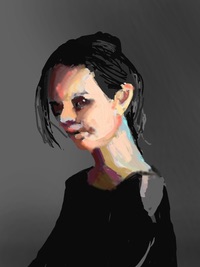
I can’t draw, but it’s fun to try – in part because I’m not good at it, and because drawing and painting require thinking about the thing rather than the symbol of the thing, and software design is always about those symbols.
There’s an iOS called Sktchy where people upload selfies and draw each others’. It’s an interesting mix: some school children, some art school students, some pro illustrators who are doing finger exercises or want to pin down some practical details. (If you want to draw ten Thai faces, or twenty colors of blonde, this is the place.) A lot of the discussion is formulaic or sentimental, but sometimes it's unexpectedly good.

So, Leigh V’s photo and my sketch. There’s stuff we can talk about. Some of it’s just ineptitude – bad draftsmanship, eyes that are pretty much symbolic, a lack of conviction about the neck, all stuff that deserves a red pencil but that’s pretty much only interesting in terms of “don’t do that if you can help it.” But there are other things, too. The color choices are not harmonized but I think some of them work. The warm shadows aren’t there in the world but they’re interesting, and the cerulean on Leigh’s neck isn’t there either but it looks right in the image. The exaggerated shadows work, too, more or less; some of the drafting errors might actually help, and if they're errors and not intentionally painterly touches, well, that’s why it’s called the intentional fallacy.
Leigh’s comment was “This remind me of Francis Bacon. But, you know, without the tortured screaming and slabs of meat.” And that’s generally where I meant to go, though maybe more Pearlstein or Freud than Bacon. But that’s an interesting conversation, too.
But we seldom have these conversations about hypertext writing.
The 2015 Coover Prize for Electronic Writing went to Samantha Gorman and Danny Cannizzaro for PRY. Sandy Baldwin won the Hayles prize for criticism for “The Internet Unconscious: On the Subject of Electronic Literature”.
Brian Crane’s intriguing hypertext on William Faulkner, Faulkner At MGM, is now online. It’s made with Tinderbox. Fascinating notes about the project as well.
Crane has been anxious that he’d never master Tinderbox export, which is flexible but has a reputation for complexity. In fact, he’d been putting off even attempting to begin.
So I bit the bullet, cut materials, linked back from dead ends where I found them, left quite a few long notes I’d planned to break up whole, and then last night (less than 24 hours ago!) sat down to see what I could get out of my Tinderbox file.
It was a revelation.
Tinderbox’s export is jaw-droopingly, amazing.

I’ve just spent the better part of a day in Storyspace. Not in Xcode building Storyspace, but actually writing new stuff in Storyspace 3. (I did need to bail and do a fresh build to address a bug, but I got all the way to 4PM before that happened. A landmark.)
Right now, I'm working on a way to integrate Storyspace and Card Shark, one of my exotic hypertext systems. The two are very different in form and rhetoric, but I expect they’ll work well together; in particular, Card Shark lets you construct tangles with more easily and more thoughtfully than pure Storyspace allowed, while focusing your concentration (and the map view) on links that participate in more interesting patterns.
For example, a chase lends itself beautifully to the tangle. Lots of stuff happens in the course of a chase. Some of it is indispensable. Some might work tonight but be better left out tomorrow; that’s what hypertext is for. Sometimes, we might keep the point of view in one place, tracking our protagonist. Sometimes, we might intercut the hero’s point of view with the enemy’s. Hypertext can do that, too.

Prendre des notes avec Tinderbox: petit guide interactif. By Dominique Renauld. In French, looks great, and just $3.99.
by Richard Price
A drunk writer who moonlights as a bartender startles his inept and inexperienced mugger; the kid flinches, the bartender falls dead, and it’s another night in the Lower East Side. The eyewitnesses turn out to be idiots who foul everything up, the police interrogation gets the wrong guy, the brass interfere, and soon the case is hopeless. The main characters are pretty hopeless as well, as nearly everyone stews in mild self-loathing. Price writes nearly everything as an interrogation; for these characters, few of whom are likable, even internal dialog is adversarial. The conceit works well while also showing us just how much is actually happening. The book, like its gentrified tenements and its Projects, is bursting with characters who are going about their business and who just happen, for a time, to cross paths with the police. Some are going upstate, some are going to make it, some are going to hell in a bucket, and some are going to Jersey: they're all going places, and almost all of them have something going.
by Emma Larkin
Emma Larkin travels through Burma, talking to lots of people and viewing the country through the prism of Burmese Days, Animal Farm, and 1984. It’s a lively and well-constructed book, and if there’s not much new to say about life under The Generals, that’s unsurprising: lots of writers, including Orwell, crafted an idiom of twentieth century totalitarianism that is very much with us today, so much so that it’s hard to see a very different way to write about it. I do wish we had fresher insight into either Orwell or his novels: I haven’t read them in years, but nothing here surprised me enough to find them again on my shelves. I wish I knew more about those who do quietly support the military regime, but their story must be even harder to uncover than that of the courageous dissident movement.
by Elizabeth Bear
Elizabeth Bear sets out to write a steampunk western, and like her spunky protagonist she’s not going to get shortchanged. We’ve got transformers and airships and submersibles. We’ve got former slaves turned federal marshal, wild Cheyennes with impeccable courtesy, feminist sex workers, a madame who can cuss for England, and a human trafficker with a license for Mad Science. We’ve got some particularly well-observed and affectionate writing about saddle horses. A city and a country are literally rising up from the muck, and it’s not always a pretty process.
